- About
- Mission Statement
Education. Evidence. Regrowth.
- Education.
Prioritize knowledge. Make better choices.
- Evidence.
Sort good studies from the bad.
- Regrowth.
Get bigger hair gains.
Team MembersPhD's, resarchers, & consumer advocates.
- Rob English
Founder, researcher, & consumer advocate
- Research Team
Our team of PhD’s, researchers, & more
Editorial PolicyDiscover how we conduct our research.
ContactHave questions? Contact us.
Before-Afters- Transformation Photos
Our library of before-after photos.
- — Jenna, 31, U.S.A.
I have attached my before and afters of my progress since joining this group...
- — Tom, 30, U.K.
I’m convinced I’ve recovered to probably the hairline I had 3 years ago. Super stoked…
- — Rabih, 30’s, U.S.A.
My friends actually told me, “Your hairline improved. Your hair looks thicker...
- — RDB, 35, New York, U.S.A.
I also feel my hair has a different texture to it now…
- — Aayush, 20’s, Boston, MA
Firstly thank you for your work in this field. I am immensely grateful that...
- — Ben M., U.S.A
I just wanted to thank you for all your research, for introducing me to this method...
- — Raul, 50, Spain
To be honest I am having fun with all this and I still don’t know how much...
- — Lisa, 52, U.S.
I see a massive amount of regrowth that is all less than about 8 cm long...
Client Testimonials150+ member experiences.
 Scroll DownPopular Treatments
Scroll DownPopular Treatments- Treatments
Popular treatments. But do they work?
- Finasteride
- Oral
- Topical
- Dutasteride
- Oral
- Topical
- Mesotherapy
- Minoxidil
- Oral
- Topical
- Ketoconazole
- Shampoo
- Topical
- Low-Level Laser Therapy
- Therapy
- Microneedling
- Therapy
- Platelet-Rich Plasma Therapy (PRP)
- Therapy
- Scalp Massages
- Therapy
More
IngredientsTop-selling ingredients, quantified.
- Saw Palmetto
- Redensyl
- Melatonin
- Caffeine
- Biotin
- Rosemary Oil
- Lilac Stem Cells
- Hydrolyzed Wheat Protein
- Sodium Lauryl Sulfate
More
ProductsThe truth about hair loss "best sellers".
- Minoxidil Tablets
Xyon Health
- Finasteride
Strut Health
- Hair Growth Supplements
Happy Head
- REVITA Tablets for Hair Growth Support
DS Laboratories
- FoliGROWTH Ultimate Hair Neutraceutical
Advanced Trichology
- Enhance Hair Density Serum
Fully Vital
- Topical Finasteride and Minoxidil
Xyon Health
- HairOmega Foaming Hair Growth Serum
DrFormulas
- Bio-Cleansing Shampoo
Revivogen MD
more
Key MetricsStandardized rubrics to evaluate all treatments.
- Evidence Quality
Is this treatment well studied?
- Regrowth Potential
How much regrowth can you expect?
- Long-Term Viability
Is this treatment safe & sustainable?
Free Research- Free Resources
Apps, tools, guides, freebies, & more.
- Topical Finasteride Calculator
- Interactive Guide: What Causes Hair Loss?
- Free Guide: Standardized Scalp Massages
- 7-Day Hair Loss Email Course
- Ingredients Database
- Interactive Guide: Hair Loss Disorders
- Treatment Guides
- Product Lab Tests: Purity & Potency
- Evidence Quality Masterclass
More
Articles100+ free articles.
-
Cannabidiol (CBD) Increases Hair Counts By 246%? Not So Fast.
-
Creatine: Does It Worsen Hair Loss? It Depends On The Hair Loss Type.
-
Can Progesterone Improve Hair Regrowth?
-
CRABP2: Can This Gene Predict Regrowth From Retinoids?
-
BTD: Can This Gene Predict Regrowth From Biotin?
-
COL1A1: Can This Gene Predict Regrowth From Collagen Support?
-
2dDR For Hair Loss: What Do We Know So Far About This Sugar?
-
CYP19A1: Can This Gene Predict Regrowth From Hormone Therapy?
PublicationsOur team’s peer-reviewed studies.
- Microneedling and Its Use in Hair Loss Disorders: A Systematic Review
- Use of Botulinum Toxin for Androgenic Alopecia: A Systematic Review
- Conflicting Reports Regarding the Histopathological Features of Androgenic Alopecia
- Self-Assessments of Standardized Scalp Massages for Androgenic Alopecia: Survey Results
- A Hypothetical Pathogenesis Model For Androgenic Alopecia:Clarifying The Dihydrotestosterone Paradox And Rate-Limiting Recovery Factors
Menu- AboutAbout
- Mission Statement
Education. Evidence. Regrowth.
- Team Members
PhD's, resarchers, & consumer advocates.
- Editorial Policy
Discover how we conduct our research.
- Contact
Have questions? Contact us.
- Before-Afters
ArticlesPeppermint Oil for Hair Growth: Better Than Minoxidil?
First Published May 1 2022Last Updated Oct 29 2024IngredientsNatural Remedies Researched & Written By:Perfect Hair Health Team
Researched & Written By:Perfect Hair Health Team Reviewed By:Rob English, Medical Editor
Reviewed By:Rob English, Medical Editor
Want help with your hair regrowth journey?
Get personalized support, product recommendations, video calls, and more from our researchers, trichologists, and PhD's dedicated to getting you the best possible outcomes.
Learn MoreArticle Summary
In 2014, a study on mice found that peppermint oil improved hair growth outcomes better than minoxidil. In 2015, a study on men with androgenic alopecia showed that topical rosemary oil (similar to peppermint) improved hair counts, and as effectively as minoxidil. While these studies appear promising, peppermint’s key constituent – menthol – is linked to both vasodilation and vasoconstriction (depending on its contact location and mode of delivery). Moreover, that 2015 study compared peppermint oil to 2% minoxidil rather than 5% minoxidil. In this article, we explore the nuanced relationship between peppermint and hair loss. Does peppermint oil live up to the hype? Find answers below.
Full Article
Peppermint oil has been used for centuries to treat a variety of health conditions including hair loss, and a 2014 clinical study suggests that peppermint essential oil facilitates hair growth. How reliable is that 2014 study? And should we consider using peppermint oil to treat hair loss?
In this article, we’ll explain what peppermint oil is, discuss its uses and health benefits, explain why peppermint essential oil is used for hair growth, review the clinical evidence supporting this claim, discuss how to use peppermint oil for hair growth, and highlight important safety precautions to take when using peppermint oil.
In This Article
- What Is Peppermint Oil?
- Peppermint Oil – Uses & Health Benefits
- Why Do People Use Peppermint Oil for Hair Growth?
- Using Peppermint Oil for Hair Growth – What Does the Clinical Evidence Suggest?
- How to Use Peppermint Oil for Hair Growth
- Precautions When Using Peppermint Oil
- Summary / Key Takeaways
What Is Peppermint Oil?
Peppermint (Mentha piperita), a cross between water mint and spearmint, is a plant that grows throughout Europe and North America. Peppermint oil is an essential oil derived from the leaves and flowers of the peppermint plant. Peppermint essential oil contains a high concentration of menthol, a compound responsible for peppermint’s cool, refreshing taste and smell, as well as its many associated health benefits.
Peppermint Oil – Uses & Health Benefits
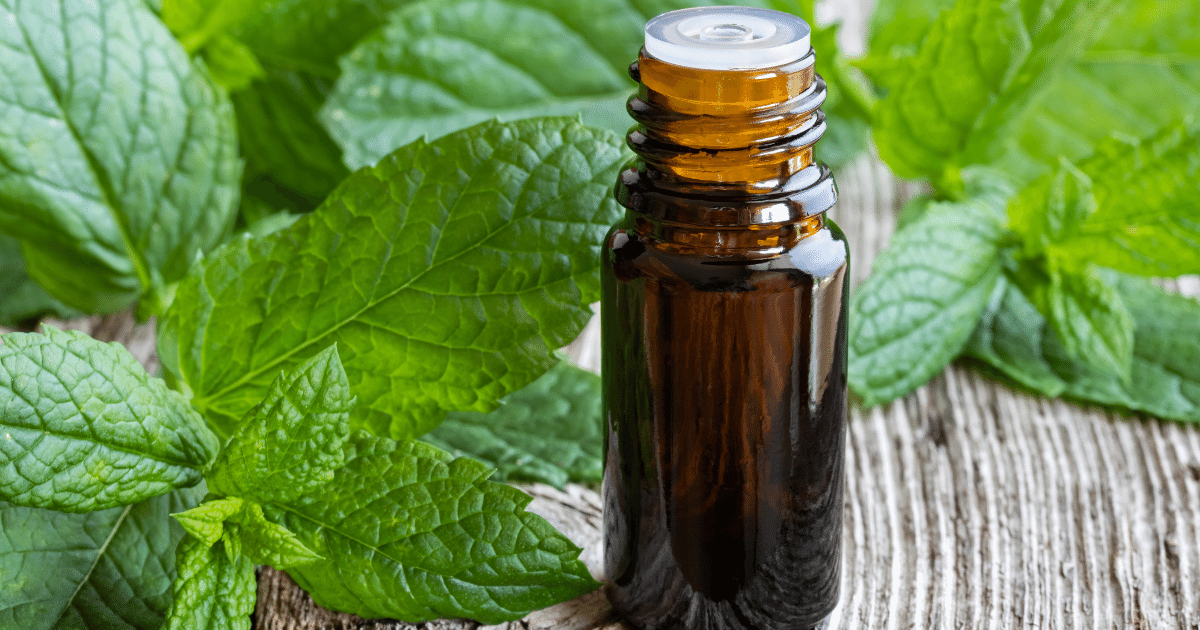
Despite its many uses and associated health benefits, only a small amount of research has been conducted on the therapeutic applications of peppermint oil, and that research focuses primarily on using peppermint essential oil to treat IBS.[1]https://www.nccih.nih.gov/health/peppermint-oil
Nonetheless, many people still use peppermint oil for its purported health benefits and properties.
- Analgesic/Anesthetic
- Antioxidative/Anti-inflammatory
- Antimicrobial
- Insecticidal/Pesticidal
- Vasodilating (and Vasoconstricting)
As such, peppermint oil is used therapeutically for an assortment of health conditions including nausea, digestive issues, irritable bowel syndrome (IBS), cold and sinus infections, headaches, muscle aches, joint pain, stress, dry scalp, and yes – even hair loss.
Why Do People Use Peppermint Oil for Hair Growth?
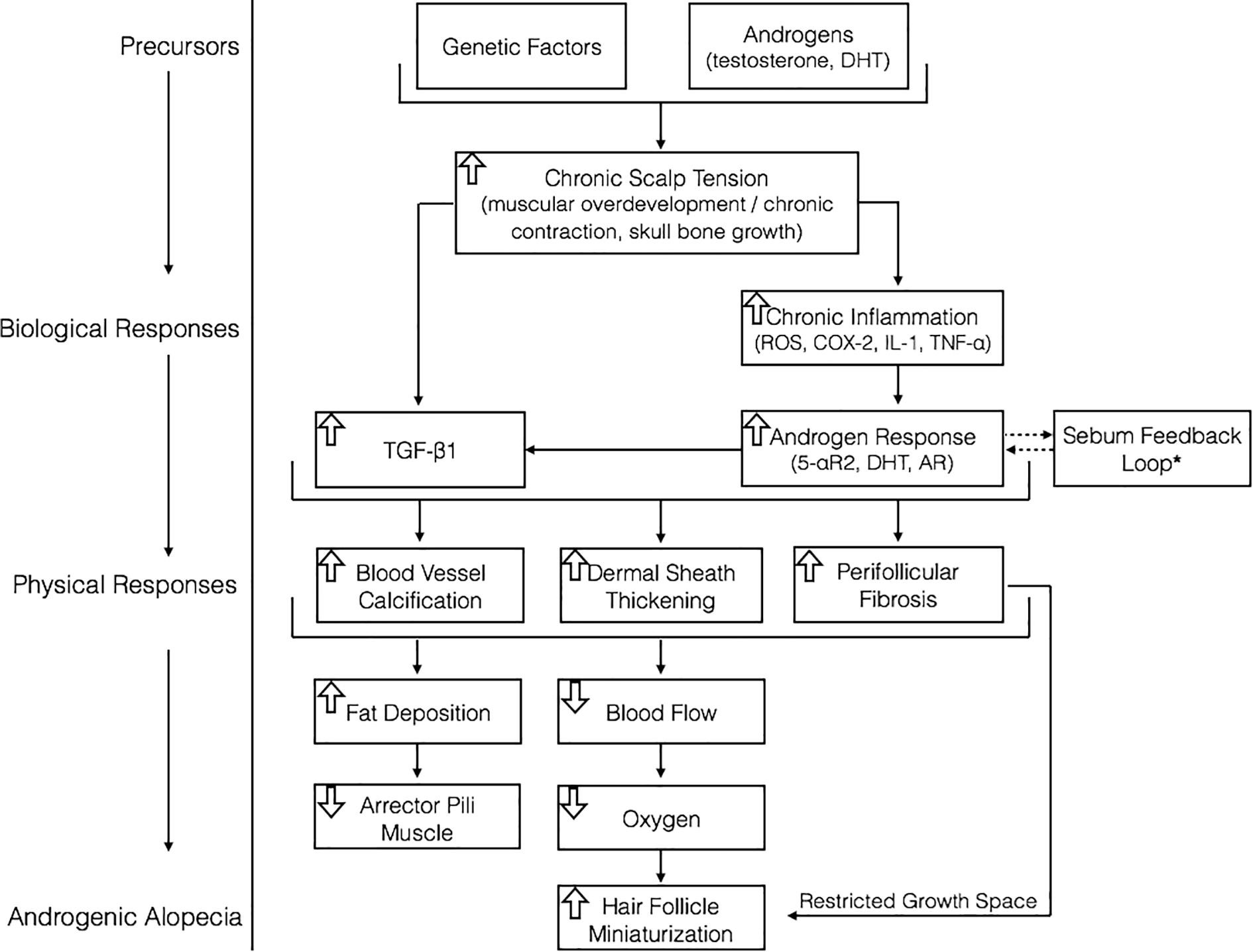
Robert S. English. (2018). An AGA model proposed that explains why poor circulation might be a cause of pattern hair loss.
What about using peppermint oil for hair growth? As noted above, peppermint essential oil is sometimes used to prevent hair loss and promote hair growth. But what is the reasoning behind its use?
We know from previous studies that balding scalps tend to have 2.6 x less subcutaneous blood supply compared to non-balding controls. Moreover, several blood-pressure-lowering medications – such as minoxidil, diaoxide, and pinacidil – have been shown to improve androgenic alopecia – one of the world’s most common hair loss disorders.
These findings implicate reduced blood supply as a potential contributor to pattern hair loss. And while it’s still debated just how much the reductions to blood flow are a cause or consequence of androgenic alopecia, there may be a therapeutic benefit to improving blood, oxygen, and nutrient levels to balding hair follicles.
This is where people believe that peppermint oil can help. The argument is often that the menthol content inside peppermint essential oil can act as a vasodilator, thereby helping to improve blood flow to the scalp. And since improving blood flow to hair follicles may be beneficial for hair growth, then perhaps applying peppermint oil might help with hair regrowth.
But what does the clinical evidence actually say about using peppermint essential oil for hair loss? As we’ll soon see, the research is far more nuanced than what the argument above may lead us to believe.
Using Peppermint Oil for Hair Growth – What Does the Clinical Evidence Suggest?
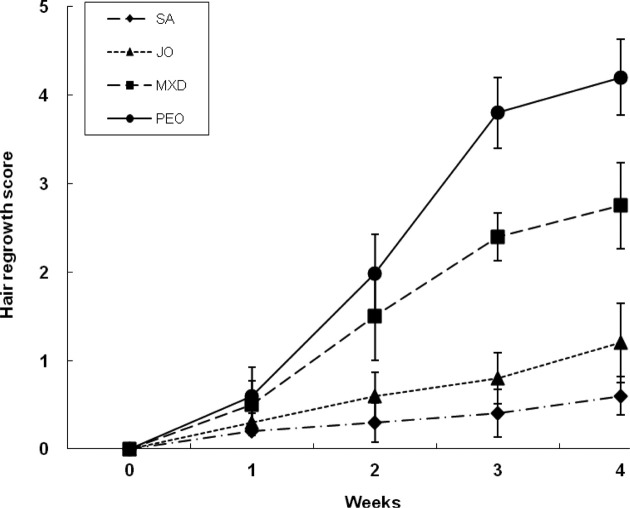
Oh JY, Park MA, Kim YC. Peppermint Oil Promotes Hair Growth without Toxic Signs. Toxicol Res. 2014;30(4):297-304.
Traditional plant remedies have been used for centuries to treat hair loss, but only a few of those remedies have been scientifically evaluated.[2]https://pubmed.ncbi.nlm.nih.gov/14996087/ And although some research has been done on the use of peppermint oil for hair growth, that research is rather limited.
That being said, the data from a 2014 study published in Toxicological Research suggests that peppermint essential oil facilitates hair growth.[3]https://www.ncbi.nlm.nih.gov/pmc/articles/PMC4289931/
2014 Study: “Peppermint Oil Promotes Hair Growth without Toxic Signs”
The 2014 study, “Peppermint Oil Promotes Hair Growth without Toxic Signs” investigated the effect of peppermint oil on hair growth in mice. The goal of the study was, “to address the therapeutic potential of peppermint essential oil for hair loss via the comparative analysis between peppermint essential oil and minoxidil.”
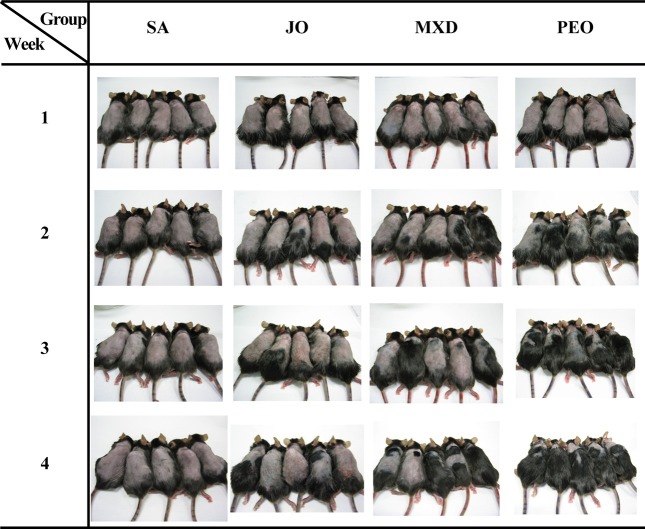
Oh JY, Park MA, Kim YC. Peppermint Oil Promotes Hair Growth without Toxic Signs. Toxicol Res. 2014;30(4):297-304.
How Was the Study Conducted?
The study was conducted by shaving the dorsal areas of 20 mice, which synchronized their hair follicles in the telogen stage of the hair cycle (i.e. the resting and shedding period of the hair cycle). The shaved mice were then randomly split into four different groups. For the next four weeks, a topical application was applied once per day, six days a week, to the shaved dorsal areas of each group:
- One group received a saline application,
- Another group received jojoba oil,
- A third group received 3% minoxidil,
- And the fourth group received 3% peppermint essential oil.
What Did the Study Measure?
Over the course of the study, the mice were analyzed in order to evaluate several different factors related to hair growth/loss. An observational analysis was conducted to evaluate hair growth. A histological analysis (i.e. the microscopic examination of body tissue) examined dermal thickness, hair follicle number, and hair follicle depth. Additional analyses were performed to evaluate alkaline phosphatase enzyme activity and mRNA expression of insulin-like growth factor-1, two known biomarkers for enhanced hair growth. Finally, body weight gain and food efficiency were evaluated in order to determine whether weight gain should be considered as a potential side effect of using peppermint oil for the treatment of hair loss.
What Were the Results of the Study?
Of the four experimental groups evaluated in the 2014 study:
- More hair growth was observed in the peppermint essential oil group.
- A histological analysis determined that the peppermint essential oil group had more significant increases in dermal thickness, hair follicle number, and hair follicle depth than the other groups – even more so than the minoxidil group.
- The peppermint essential oil group showed greater alkaline phosphatase enzyme activity and greater expression of insulin-like growth factor-1 than the other groups.
- Body weight gain and food efficiency were not significantly different between groups.
What Are the Key Takeaways from the 2014 Study?
These results suggest that peppermint essential oil could be used as a practical agent for hair growth without change of body weight gain or food efficiency. In its conclusion, the study noted that, “our experimental data suggest that 3% peppermint essential oil facilitates hair growth by promoting the conservation of vascularization of hair dermal papilla, which may contribute to the induction of early anagen stage. In addition, PEO effectively stimulated hair growth in an animal model via several mechanisms and thus could be used as a therapeutic or preventive alternative medicine for hair loss in humans.”
How Reliable is the 2014 Study?
Given that the peppermint essential oil group showed more hair growth, more significant increases in dermal thickness, a greater number of hair follicles, and greater hair follicle depth than the other groups; as well as the fact that the peppermint essential oil group showed greater alkaline phosphatase enzyme activity and greater expression of insulin-like growth factor-1 (two biomarkers that may enhance hair growth) than the other groups; it’s easy to conclude that peppermint essential oil can be used as a practical agent for hair growth.
Does this mean you should rush to the store to purchase some peppermint oil? Well, maybe not.
Despite the conclusions of the 2014 study, there are (at least) three major issues with it:
Issue #1 – The 2014 Study Was an Animal Study
Since this was an animal study, its translatability to humans with androgenic alopecia is very limited.
For instance, mice don’t tend to suffer from hair follicle miniaturization – the defining characteristic of androgenic alopecia. Some mice species also have synchronized hair cycles, which humans don’t (that’s why adult men and women tend to shed 100-150 hairs daily, even in the absence of a hair loss problem).
In fact, the researchers in this study used the synchronicity of this species’ hair cycle as the basis for their study by simply shaving the mice. Whether or not this truly synchronizes the hair follicles is still debated, as shaving doesn’t necessarily trigger the degeneration and regeneration of new hair follicles in mice. Rather, it just trims down the existing hairs themselves. (Synchronization likely requires plucking.)
The key point is that these mice are not suffering from androgen-mediated hair loss, which is the condition we see more often in humans. So while these study results look great on face value, their translatability is likely pretty low for men and women with pattern hair loss. Or, to put it another way, just because an ingredient produces results in mice, that doesn’t necessarily mean you’ll see the same effects in humans.
Issue #2 – The 2014 Study Was Conducted on a Small Sample of Mice
This study was conducted on only 20 mice, which isn’t a large enough sample size to fully trust the results. Furthermore, those 20 mice were split into four groups of five, and in order to conduct a histological analysis, mice from each of those groups had to be euthanized throughout the course of the study.
As a result, any conclusions drawn about the effects of peppermint essential oil were based on an analysis of five (or fewer) mice. The bottom line is that there just isn’t a large enough sample size to be statistically reliable. We cannot allow five mice to dictate our choices for frontline therapeutics while fighting androgenic alopecia – at least not without other evidence.
Issue #3 – The 2014 Study Took Place Over Only Four Weeks
The study was only four weeks long, and that most likely isn’t enough time to effectively measure the effects of peppermint essential oil (or any topical application) on hair growth.
Keep in mind that, in humans, well-designed clinical trials for hair growth interventions last at least 12 months. This is important for a variety of reasons: accounting for the speed of new hair growth, controlling for seasonal fluctuations to hair cycling, and a host of other factors that make results at 1+ years a lot more relevant than results at only 4 weeks.
Take the hair loss drug minoxidil as a perfect example. Clinical studies show that minoxidil’s hair growth-promoting effects tend to peak around week 12, but trend downward thereafter. Without longer studies, we would have never known this.
Conclusion on the Reliability of the 2014 Study
Although the results from the 2014 study are intriguing, they aren’t conclusive enough to prove that peppermint oil is effective at promoting hair growth in humans. That’s not to say we should dismiss the results entirely; it’s just to say that without better evidence, we want to exercise caution when choosing to include peppermint oil as part of our hair regrowth regimen.
Are There Any Other Studies That Might Shed Some Light on the Effects of Peppermint Essential Oil on Hair Growth?
The 2014 study is the only current study that examines the effects of peppermint essential oil on hair growth. Although there are no other such studies, there are at least two other areas of clinical research we can look to in order to shed additional light on the possible effects of using peppermint essential oil for hair growth.
First, we can look to current studies examining the effects of menthol on vasculature (i.e. the network of blood vessels connecting the heart with all other organs in the body). The 2014 study theorized that peppermint essential oil facilitates hair growth by improving blood flow to hair follicles; and the study’s authors suggested that these effects are due to menthol, which accounts for 40% of peppermint oil’s volatile acids. Although there are no other studies on the effects of peppermint oil on hair growth, there are several studies that offer additional insight into how menthol affects vascularization (i.e. the process of growing blood vessels into a tissue in order to improve oxygen and nutrient supply). Those other studies were summarized in a 2020 research paper published in Frontiers in Physiology.[4]https://www.ncbi.nlm.nih.gov/pmc/articles/PMC7154148/
Second, we can look to the one clinical study that examines the effects of essential oil on androgenic alopecia in humans.[5]https://pubmed.ncbi.nlm.nih.gov/25842469/ Although this study examines the effects of rosemary oil rather than peppermint oil, it was conducted on 100 humans over a six-month period and it looked specifically at the effects of essential oil on androgenic alopecia, which means its findings are both more reliable and applicable than the 2014 study.
What Does the 2020 Research Paper Say About the Effects of Menthol on Vascularization?
As noted above, a 2020 research paper summarizes the findings from various clinical studies on the effects of menthol on vascularization. Among other things, the 2020 research paper 1) identifies a number of currently known mechanisms underlying both vasodilation (i.e. the dilation of blood vessels) and vasoconstriction (i.e. the constriction of blood vessels) responses associated with the application of menthol, and 2) examines the results of the most relevant in vivo studies in order to make three important observations about the effects of menthol on the vasculature.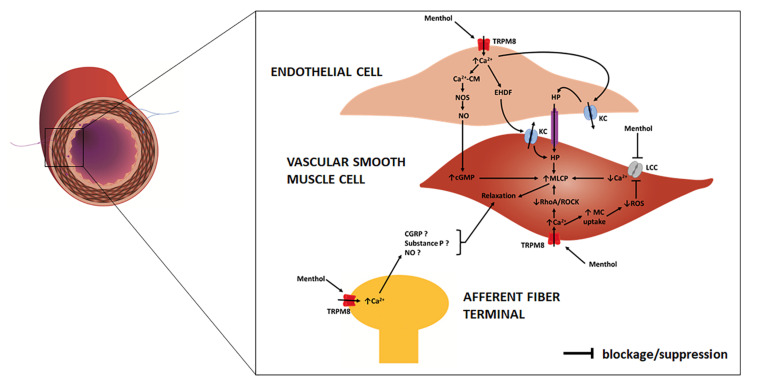
Silva H. Current Knowledge on the Vascular Effects of Menthol [published correction appears in Front Physiol. 2020 Oct 20;11:602231]. Front Physiol. 2020;11:298. Published 2020 Apr 7.
Known Mechanisms Underlying Vasodilation and Vasoconstriction Responses Associated with the Application of Menthol
Menthol is a versatile molecule with complex actions on vasculature – many of which are still being discovered. Studies have identified several cellular targets for menthol in the vascular endothelium, vascular smooth muscle, and in sensory nerve fibers:
- Menthol has been shown to act on TRPM8 channels in the vascular endothelium, vascular smooth muscle, and in afferent nerve fibers. In the vascular endothelium, the application of menthol causes a series of responses resulting in vasodilation, whereas in the vascular smooth muscle, the application of menthol causes a series of responses resulting in vasoconstriction.
- Menthol has also been shown to block voltage-gated calcium channels, resulting in vasodilation.
- Menthol has also been shown to act on RhoA/ROCK pathways, resulting in vasodilation.
Other potential targets for menthol have been identified – such as TRPA1 and TRPV channels – although the vascular effects of menthol application on these target areas has not been studied:
Examining the Results of the Most Relevant In Vivo Studies
Based on the known mechanisms underlying the vascular responses associated with menthol, it is clear that menthol is capable of causing both vasodilation and vasoconstriction. However, some of those results were from in vitro studies, which aren’t nearly as relevant as studies of living tissue. The 2020 research paper also looked specifically at the results of the 16 most relevant in vivo studies, leading to some important observations, which we’ll discuss in a bit.
Of the 16 in vivo studies examined in the 2020 research paper:
- Six of the 16 studies linked menthol application to blood flow decrease.
- Eight of the 16 studies linked menthol application to blood flow increase.
- One of the 16 studies did not link menthol application to either blood flow increase or decrease.
- One of the 16 studies linked menthol to blood flow increase in certain contexts and no change in blood flow in other contexts.
These observations are summarized in the following table:
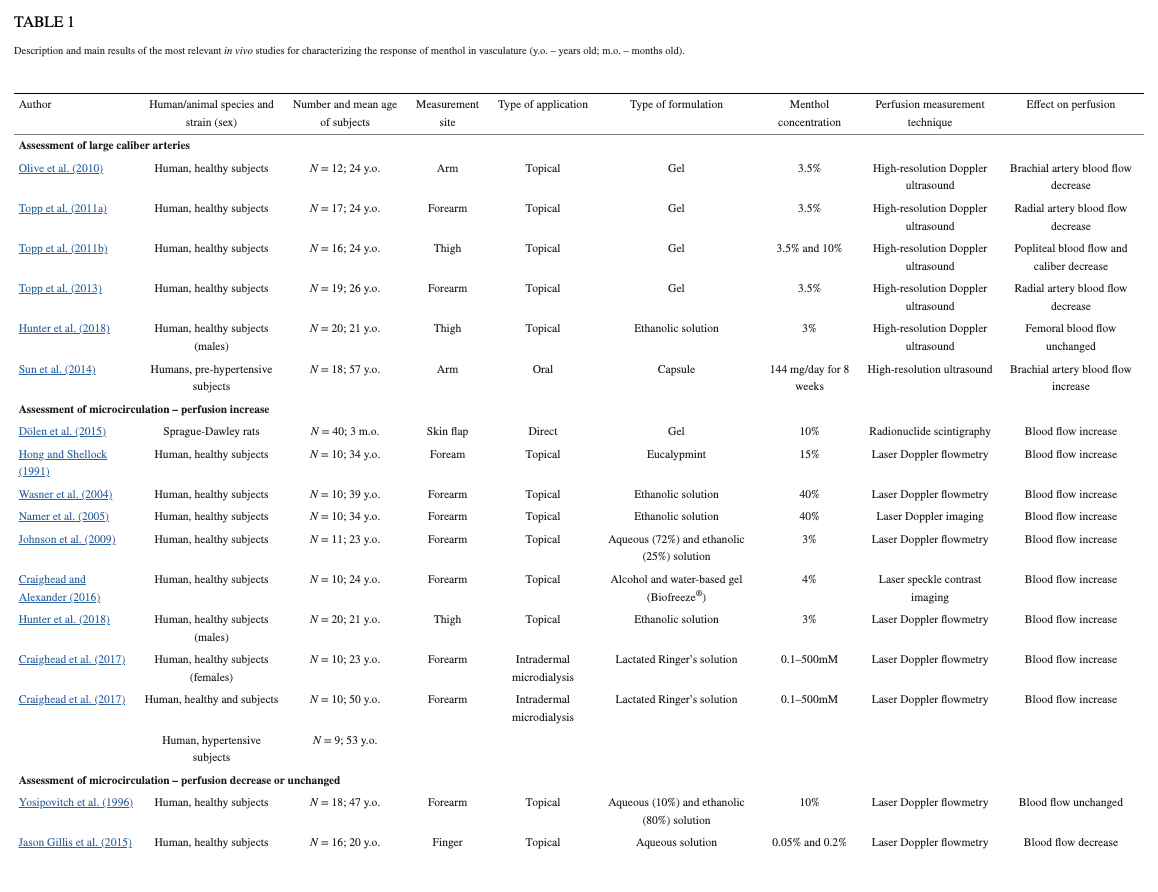
Current Knowledge on the Vascular Effects of Menthol, Henrique Silva
Looking at these findings at a high level, menthol application appears to be generally linked to both vasodilation and vasoconstriction. This makes sense, as the known mechanisms associated with the application of menthol can cause both vasodilation and vasoconstriction. However, the 2020 research paper makes two important observations about the results of the 16 in vivo studies.
Observation #1 – Large Caliber Arteries vs. Microcirculation:
The first important observation made by the 2020 research paper was that, “large caliber arteries respond mainly to menthol application with perfusion decrease while cutaneous microcirculation responds mainly with perfusion increase.” In other words, menthol application decreases blood flow in large arteries while increasing blood flow in the smaller arteries and capillaries that supply blood to the skin.
Encouragingly, this might have direct application to the loss of blood flow seen in androgenic alopecia. While debate still exists over cause-and-effect, it is generally believed that reductions to blood flow in androgenic alopecia are mainly due to loss of the microcapillary networks (i.e., the small blood vessels supporting the hair follicles themselves), rather than reductions from the carotid arterial branches supporting those microcapillary networks.
Indeed, when we look at the 16 in vivo studies and account for whether perfusion was measured in large-caliber arteries or cutaneous microcirculation, we find the following:
- Of the six studies that reported a decrease in blood flow, four of them assessed the blood flow of large caliber arteries, and only two of them assessed blood flow in cutaneous microcirculation.
- Of the nine studies that reported an increase in blood flow, eight of them assessed blood flow in cutaneous microcirculation, while only one assessed blood flow in large-caliber arteries.
- Of the two studies that reported no increase or decrease in blood flow, one of them assessed blood flow in cutaneous microcirculation and the other assessed blood flow in large-caliber arteries.
So, for the most part, the above observation is confirmed by the results. This is an important observation because if menthol application improves blood flow in microcirculation, that means it might improve blood flow in the microcirculation that feeds hair follicles in the scalp, which may improve hair growth.
Observation #2 – Provoked vs. Non-Provoked Skin:
The 2020 research report also made an important observation about the application of menthol and its effects on cutaneous microcirculation. The report noted that “The microcirculation response to topically applied menthol seems to depend on whether the assessed skin region was directly provoked with menthol or not.” In non-provoked skin, menthol is reported to induce cutaneous perfusion decrease, while in provoked skin, it has been found to increase microcirculatory perfusion.
This is an important observation because if menthol application increases blood flow in provoked skin regions, it could theoretically increase blood flow to the scalp, perhaps resulting in improved hair growth. At the same time, because non-provoked skin regions experience decreased blood flow, any areas of the scalp not provoked by menthol could experience decreases in blood flow.
Observation #3 – The Unintended Effects of Ethanol on the Vasculature:
Although studies have linked the application of menthol to vasoconstriction and decreased perfusion in both large caliber arteries and non-provoked cutaneous microcirculation, it is possible that these effects are not actually caused by menthol. Instead, vasoconstriction may be caused by evaporative heat loss due to ethanol, which is often used in topical menthol applications due to its low water solubility.
In provoked skin cells, any vasoconstrictive reflex caused by ethanol would most likely be offset by menthol-mediated vasodilation.
What Do the 2020 Research Paper Findings Suggest About the Use of Menthol for Hair Growth?
At first glance, the observations made in the 2020 research paper seem rather promising. The paper notes that perfusion increases in skin regions that have been directly provoked with menthol. This would suggest that applying a topical menthol solution to the scalp may increase blood flow to the region, which could theoretically induce anagen-stage hair growth. Furthermore, perfusion decreases in non-provoked skin regions may be attributed to the presence of ethanol in topical formulations, rather than menthol itself. If this is the case, one might consider searching for a topical menthol application that doesn’t employ ethanol in its formulation.
While promising, the observations made in the 2020 research paper should be taken with a grain of salt. For one, the report itself concludes that menthol’s actions on vasculature remain unclear. Some of menthol’s actions on vasculature have only been studied in vitro while other actions of menthol on vasculature have not been studied at all. Secondly, it is important to note that the 2020 research paper examined the effects of menthol on vasculature. And while menthol is the primary component of peppermint oil, it is not peppermint oil. Peppermint oil contains other volatile acids, the effects of which are not examined in the 2020 research paper. Finally, although menthol has been shown to increase perfusion in provoked skin tissue, this doesn’t necessarily mean that it will increase perfusion in scalp tissue. None of the studies examined in the 2020 research paper looked specifically at the effects of peppermint oil on scalp tissue perfusion, let alone hair loss.
What About the 2015 Study, “Rosemary oil vs minoxidil 2% for the treatment of androgenetic alopecia: a randomized comparative trial”
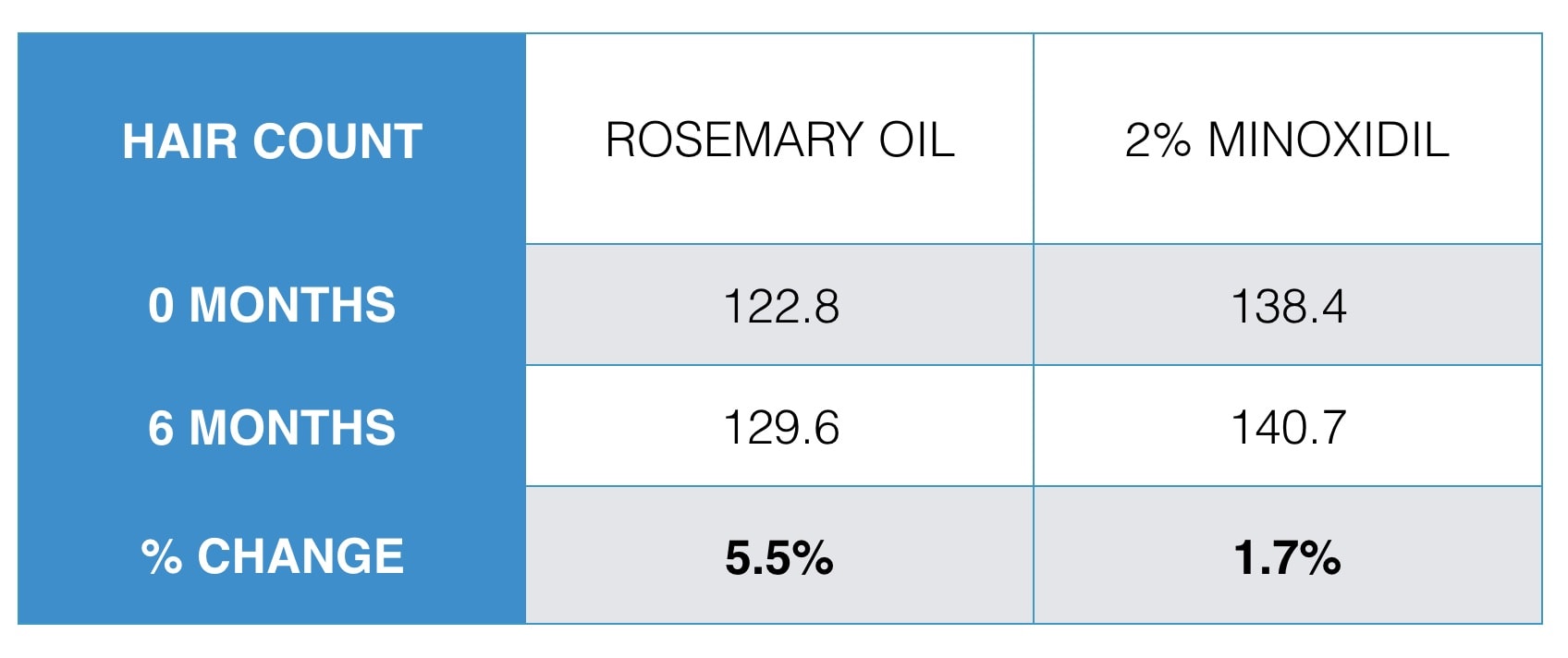
Citation: Panahi Y, Taghizadeh M, Marzony ET, Sahebkar A. Rosemary oil vs minoxidil 2% for the treatment of androgenetic alopecia: a randomized comparative trial. Skinmed. 2015 Jan-Feb;13(1):15-21. PMID: 25842469.
At this point, we’ve looked at evidence from the 2014 study, which suggests that peppermint oil improves hair growth in mice (who do not suffer from androgenic alopecia). The 2014 study authors concluded that some of these hair growth effects are due to menthol, which accounts for 40% of peppermint oil’s volatile acids. Thus, we looked to the 2020 research paper, where we found human trials demonstrating that topical application of menthol can improve blood supply to specific tissues. All of these things give us positive signals that menthol may help with androgenic alopecia. However, given that these effects haven’t been measured in human scalps with androgenic alopecia, it’s unclear just how helpful menthol (and by extension, peppermint oil) will be for treating hair loss.
What we’d really love to see is a study of peppermint oil’s effects on hair growth in human subjects with androgenic alopecia.
Although there isn’t currently a study of peppermint oil’s effects on hair growth in human subjects with androgenic alopecia, we can get pretty close by referring to a 2015 study on the effects of rosemary oil on hair growth.[6]https://pubmed.ncbi.nlm.nih.gov/25842469/
Although this study examines the effects of rosemary oil rather than peppermint oil, it was conducted on 100 humans over a six-month period, which makes the findings much more reliable than the 2014 study. In addition, this study looked specifically at the effects of essential oil on androgenic alopecia, which means its findings are more applicable to pattern hair loss than the 2014 study. Finally, rosemary is in the same plant family (Lamiaceae) as peppermint, and rosemary essential oil has many of the same associated health benefits as peppermint essential oil (both are anti-inflammatory, antibacterial, and vasodilating).
How Rosemary May Help Hair Loss
Before we discuss the findings from the 2015 study, it’s important to review the reasons that rosemary essential oil may be useful for preventing pattern hair loss.
Reason #1 – Rosemary Oil is Anti-Inflammatory:
There’s evidence suggesting that chronic scalp inflammation contributes to hair loss. When scalps are chronically inflamed, they begin to develop scar tissue. Over time, this scar tissue chokes hair follicles, depriving them of blood, oxygen, and nutrients until the hair follicles shrink and eventually stop regrowing.
Fortunately, rosemary essential oil has been shown to reduce cytokines (a type of signaling protein) and cyclooxygenase 2 (a type of enzyme) – both of which are involved in the pro-inflammatory process. And when it comes to inflammation and hair loss, the more we can reduce inflammation, the better our chances to prevent hair loss and regrow hair.
Reason #2 – Rosemary Oil is Antibacterial:
Although we cannot see them (and probably don’t want to), the human body contains trillions of microorganisms, which outnumber human cells by 10 to 1.[7]https://www.nih.gov/news-events/news-releases/nih-human-microbiome-project-defines-normal-bacterial-makeup-body And while most bacteria that live on the skin are innocuous, some can produce inflammatory byproducts that increase inflammation in our tissues. When pro-inflammatory bacteria and fungi colonize our scalps, they can create a chronic inflammatory state that triggers the hair loss process.
Some studies suggest that rosemary extracts can significantly reduce the size of pathogenic bacteria and biofilm colonies. In other words, rosemary oil may help fight hair loss by killing the bacteria that puts our scalps in a chronically inflamed state.
Reason #3 – Rosemary Oil May Reduce DHT Levels:
If you’ve read any of our other articles, you’ve probably heard about the hormone dihydrotestosterone (DHT) and its connection to hair loss. While the exact mechanisms are still being discovered, evidence strongly suggests that DHT is causally associated with hair follicle miniaturization – the defining characteristic of male pattern baldness.
Luckily for us, rosemary leaf extract has been shown to improve hair regrowth by inhibiting the androgen receptors that DHT uses to bind to skin cells and influence cell function.[8]https://pubmed.ncbi.nlm.nih.gov/22517595/
Reason #4 – Rosemary Oil May Prevent (or Reduce) Fibrosis:
Chronic inflammation in the scalp eventually leads to fibrosis, or scar tissue formation. In pattern hair loss, fibrosis occurs around the hair follicles. Over time, scar tissue chokes hair follicles, depriving them of blood flow, oxygen, and nutrients.
Fortunately, rosemary oil not only helps prevent fibrosis, it may stop scar tissue from forming in the first place. Although there have been no studies evaluating the effects of rosemary oil on follicular fibrosis (i.e. scarring of hair follicle tissues), multiple studies on rats have shown that certain organic compounds found in rosemary oil, known as polyphenols, help protect against the formation of scar tissue. Some studies have even suggested that rosmarinic acid, a type of polyphenol found in rosemary oil, prevents scar tissue formation by reducing the expression of transforming growth factor beta one (TGFβ-1) – a signaling protein that’s elevated in balding scalp tissue.[9]https://pubmed.ncbi.nlm.nih.gov/22095555/
Reason #5 – Rosemary Oil Increases Blood Flow:
When scar tissue forms around hair follicles, it reduces the amount of blood flow to those hair follicles. And when blood flow is reduced, those hair follicles receive less oxygen and nutrients, causing them to thin and eventually disappear.
Rosemary oil not only helps prevent scar tissue from forming, it also increases vasodilation in the areas where it is applied. In one study, researchers examined the effects of rosemary extract on rats that had received soft tissue reconstruction surgery with skin flaps. Not only did the rats treated with rosemary extract have better skin graft survival, they also had larger diameter blood vessels. The researchers inferred that the vasodilatory effects of rosemary extract were largely responsible for the improved skin graft survival.[10]https://pubmed.ncbi.nlm.nih.gov/27994918/
What Were the Results of the 2015 Rosemary Study?
As noted above, the 2015 research study evaluated 100 men with pattern hair loss (i.e. androgenic alopecia). Rosemary oil was applied to the scalps of fifty men, while the other fifty received an application of 2% minoxidil.
After six months of twice-daily application, the men who received the rosemary oil application showed a significant increase in scalp hair count – just as much as the group that received the 2% minoxidil application. These findings suggest that rosemary oil may be just as effective as Rogaine for treating hair loss, but without any of the side effects associated with Rogaine.
How Reliable Are the Findings from the 2015 Study?
At first glance, the results from the 2015 study look promising. For one, the study was conducted on humans rather than rats. Human hair studies are hard to come by, and when studies show hair growth in rats, those results rarely carry over to humans.
Secondly, the study was done over a six-month period, which is a more realistic time frame for studying hair growth when compared to the four-week evaluation period used by the 2014 study.
Finally, the 2015 study showed that rosemary oil not only increased hair count, but it was just as effective as 2% minoxidil at doing so.
While the results from the 2015 study offer promise for using rosemary to treat hair loss, there are at least two reasons to question the results.
Reason #1 – The 2015 Study Evaluated 2%, Rather than 5%, Minoxidil:
In comparing the effectiveness of rosemary oil to minoxidil for treating hair loss, researchers used a 2% minoxidil solution. However, 5% dilutions are more commonly used when treating hair loss. In order to truly evaluate the effectiveness of rosemary oil versus minoxidil, another study would need to be conducted using a 5% minoxidil solution.
Reason #2 – Hair Count Increases Were Not Very Significant:
While the 2015 study’s abstract makes the results look rather enticing, it’s worth noting that it doesn’t include any numbers. When a study’s abstract excludes numbers, it’s typically a good indication that the numbers aren’t all that exciting. This is the case with the 2015 study.
When we dug into the study to find actual numbers, we learned that after six months, the rosemary oil subjects saw a 5.5% increase in hair count, while the minoxidil group saw a hair count increase of just 1.7%. And when you take into account the standard deviations, these results are barely statistically significant.
These results beg the question whether the hair count increases were due to seasonality, rather than rosemary oil or minoxidil. Hair count changes of less than 10% may be attributable to seasonal shedding rather than topical application. And because this study did not have a control group, we don’t know how much of the hair count increases we can attribute to normal seasonality.
This issue becomes more compelling when we look at the before-and-after photos included with the study. Researchers highlighted one before-and-after photo for each group. Here is the before-and-after photo of a rosemary oil subject:
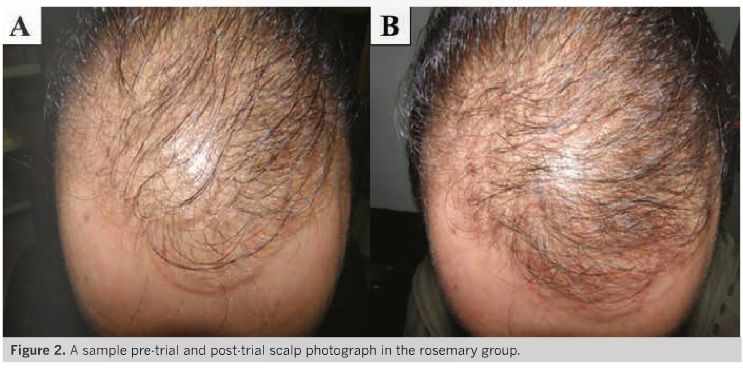
Panahi Y, Taghizadeh M, Marzony ET, Sahebkar A. Rosemary oil vs minoxidil 2% for the treatment of androgenetic alopecia: a randomized comparative trial. Skinmed. 2015 Jan-Feb;13(1):15-21. PMID: 25842469.
After seeing the photos of actual hair counts, the study’s key takeaway becomes that much more apparent. In our opinion, the major finding of this study probably isn’t that rosemary oil increases hair counts, but rather, that 2% minoxidil (for men) isn’t very effective at treating hair loss.
Final Thoughts on the Reliability of the 2015 Rosemary Study:
Despite everything noted above, the rosemary oil group still showed a 5.7% increase in hair count. And seasonality aside, there’s a decent chance that both the rosemary oil group and the minoxidil group would have lost hair over the same period had they not received either treatment.
To learn more about the 2015 study on the effects of rosemary oil for treating hair loss, please check out our article on the subject.
Given the Clinical Evidence, Should You Use Peppermint Oil for Hair Growth?
Although the above evidence is promising, we need to conduct more research in order to better understand how peppermint oil works and whether or not it’s a reliable treatment for stimulating hair growth and stopping hair loss. At this point in time, there just isn’t enough evidence to definitively state that peppermint oil works for promoting hair growth in humans.
Nevertheless, the argument we often see made in support of peppermint oil’s use for hair growth often goes something like this:
- Along with finasteride, topical minoxidil is one of two products sanctioned by the FDA for hair loss treatment.
- Minoxidil was originally created as a hypertension medication by Upjohn Pharmaceuticals, and Upjohn has warned of possible negative side effects of the medication including increased heart rate, difficulty breathing, rapid weight gain, edema, seborrhoeic dermatitis, scalp itching, and scaling.[11]https://pubmed.ncbi.nlm.nih.gov/9589208/[12]https://pubmed.ncbi.nlm.nih.gov/2230218/[13]https://pubmed.ncbi.nlm.nih.gov/12213548/[14]https://pubmed.ncbi.nlm.nih.gov/14996087/
- Although the currently available evidence for using peppermint oil to treat hair loss is inconclusive, peppermint oil did outperform Minoxidil in the 2014 study. In addition, rosemary oil, which is closely related to peppermint oil, has shown some promise for regrowing hair in humans.
- As such, it may be worth it to test peppermint essential oil as a treatment for androgenic alopecia.
What about Combining Peppermint Oil with Other Hair Loss Treatments?
It’s also worth noting that peppermint essential oil may become more effective when combined with other hair loss interventions:, such as microneedling. A 2013 study in the International Journal of Trichology compared whether treatment with Rogaine + once weekly microneedling sessions was more effective than using Rogaine alone.[15]https://www.ncbi.nlm.nih.gov/pmc/articles/PMC3746236/ After twelve weeks, the Rogaine + once weekly microneedling sessions resulted in four times the hair regrowth of just using Rogaine alone.
In the above case, a vasodilator (Rogaine or rosemary oil) was used in combination with some form of mechanical stimulation (microneedling). Given that peppermint oil has been shown to be a vasodilator, it stands to reason that it too could be used in combination with mechanical stimulation to help regrow hair. So, if you’re planning to test out peppermint essential oil to treat hair loss, we recommend also trying it alongside mechanical stimulation therapies – like microneedling – to further enhance your potential for hair regrowth.
If any readers decide to test peppermint essential oil to treat hair loss, we’d love to hear about your results.
How to Use Peppermint Oil for Hair Growth
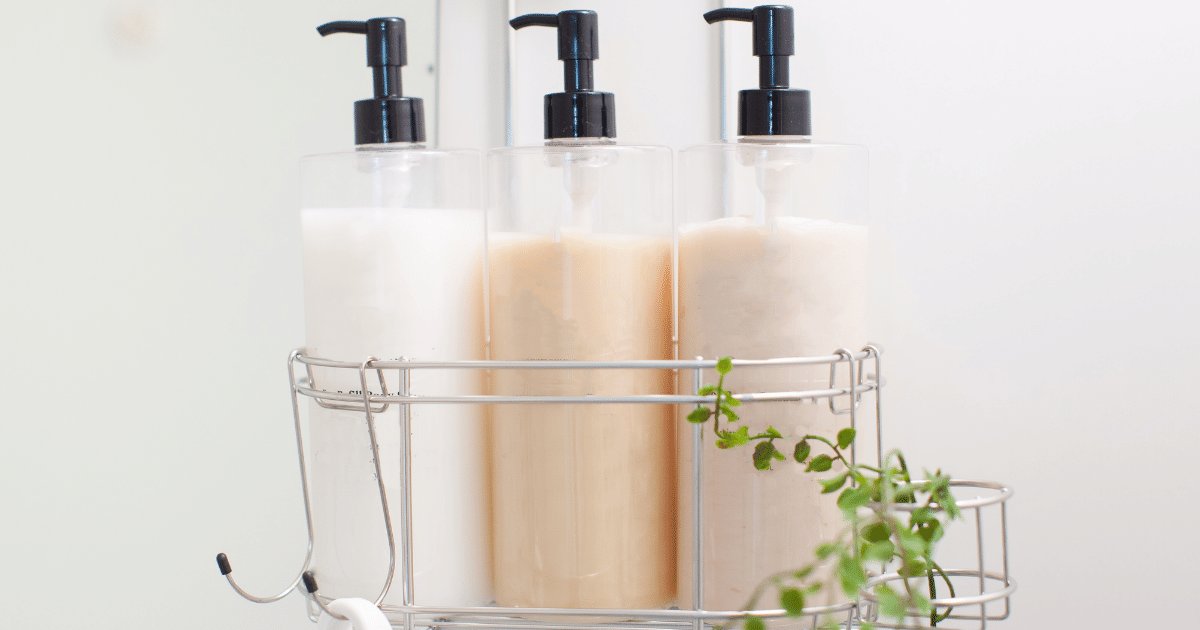
There are at least three ways to use peppermint oil to treat hair loss.
Method #1 – Buy Shampoos and Conditioners that Contain Peppermint Oil
The first method for using peppermint oil to treat hair loss is to buy shampoos and conditioners that contain peppermint oil. Peppermint oil is often used in shampoos, conditioners, and other hair care products to create a cool, clean feeling on the scalp while also enhancing the product’s scent. However, if the concentration of peppermint oil is not listed on the product label, it makes it difficult to determine whether the product contains enough peppermint essential oil to induce hair growth.
Method #2 – Add Peppermint Oil Directly to Your Shampoo or Conditioner
The second method for using peppermint oil to treat hair loss is to add peppermint oil directly to your shampoo or conditioner. This helps ensure that you’re using high-quality peppermint essential oil. There are two ways of doing this:
- Put the peppermint oil straight into your shampoo or conditioner bottle. You should add about three to five drops of peppermint essential oil per ounce of shampoo or conditioner (for reference, the 2014 study on the effects of peppermint oil used a 3% dilution), then use your shampoo or conditioner as you normally would.
- Mix the peppermint essential oil with the hair product in your hand before applying it to your hair. With this method, you should add one or two drops of peppermint oil to the hair product in your hand, mix it, and apply to your hair like you normally would.
Method #3 – Massage Peppermint Oil Directly Into Your Scalp
The third method for using peppermint oil to treat hair loss is to massage the peppermint oil directly into your scalp. As with most essential oils, the pure form of peppermint oil is too strong and will irritate your skin. For this reason, you should dilute the peppermint essential oil using a carrier oil, such as jojoba oil. To do this, add one or two drops of peppermint essential oil to about one tablespoon of scalp massage oil, coconut oil, jojoba oil, or shea butter oil. After mixing those ingredients together, massage the oil into your scalp. Leave the treatment on your scalp for 15 to 20 minutes, then wash your hair with shampoo.
Precautions When Using Peppermint Oil
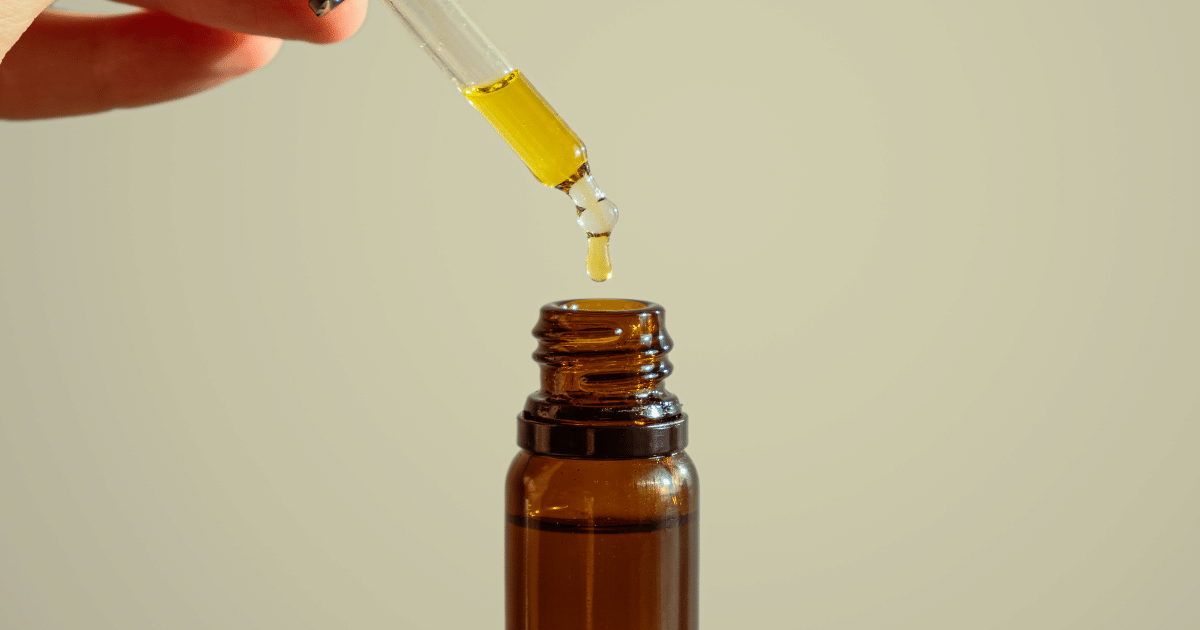
Peppermint essential oil is not the same as other peppermint products found in stores. Because essential oils are a highly concentrated form of plant extracts, a few drops of peppermint essential oil can have a much more potent effect than drinking herbal tea made from peppermint leaves or taking a capsule that contains peppermint plant extracts. Because of its high concentration of plant extracts, peppermint essential oil should be used with care to avoid reactions, side effects, or toxicity.
When applied topically or taken orally in normal doses, peppermint oil is generally safe for most people. The FDA has classified peppermint essential oil as being generally recognized as safe.[16]https://www.accessdata.fda.gov/scripts/cdrh/cfdocs/cfcfr/CFRSearch.cfm?fr=182.20
And while a report from the American Academy of Family Physicians states that peppermint oil can be toxic in high doses, that report also notes that the small amount of peppermint essential oil included in most products is probably safe.[17]https://www.aafp.org/afp/2007/0401/p1027.html
Despite its relative safety, there are some precautions you’ll want to keep in mind when using peppermint oil.
Precautions When Applying Peppermint Oil Topically
When applied topically, peppermint oil may cause skin irritation or rashes. Here are some tips to prevent skin irritation and burning:
- When purchasing peppermint oil, check the label to make sure the product has an acceptable grade for making contact with the skin.
- Before applying peppermint essential oil to your skin or scalp, dilute it with a carrier oil, such as coconut oil, jojoba oil, or shea butter oil. Don’t use a diffuser oil, warming oil, or extracts not made for skin contact.
- Be careful to avoid applying peppermint oil to the eyes or the sensitive skin around the eyes. This can cause burning, irritation, and pain to occur.
When applying peppermint essential oil topically, a light tingle is desirable. However, burning or too much tingling may mean that the oil is too strong. If this happens, immediately rinse the topical product from your skin and hair, then try using less peppermint oil the next time. If burning or irritation continues after you’ve rinsed away the peppermint oil, you should consult a physician.
Additional Precautions
When taken orally, peppermint oil may cause dry mouth, heartburn, nausea, abdominal pain, and in rare cases, allergic reactions. You should never consume undiluted essential oils.
Products containing peppermint oil should not be inhaled by or applied to the face and chest of infants or small children, as peppermint oil may cause breathing problems when the menthol is inhaled.
Key Takeaways (TL;DR)
- Peppermint oil is an essential oil derived from the leaves and flowers of the peppermint plant. The primary ingredient of peppermint essential oil is menthol, a compound responsible for many of peppermint oil’s health benefits, as well as its cool, refreshing taste and smell.
- Because of its minty taste and fragrance, as well as its many associated health benefits, peppermint essential oil is used in a variety of health and beauty products.
- Despite its traditional usage for a wide variety of health purposes, only a small amount of research has been done to evaluate the health benefits of peppermint essential oil.
- People use peppermint essential oil for hair growth because it is a vasodilator that helps improve blood flow, and reduced blood supply has been implicated as a potential contributor to pattern hair loss (i.e. androgenic alopecia).
- A 2014 study published in Toxicological Research suggests that peppermint essential oil facilitates hair growth. However, the study was conducted on mice rather than humans, and it involved a sample size of just 20 mice.
- Given the importance of scalp vascularization for hair growth, we can also look to studies on the vascular effects of menthol – the primary ingredient in peppermint oil. There are a handful of studies that suggest that perfusion increases in skin regions that have been directly provoked with menthol. However, these studies also suggest that perfusion decreases in non-provoked skin cells, and note that menthol’s actions on the vasculature remain unclear.
- Since rosemary is in the same plant family as peppermint, and because rosemary essential oil has many of the same health benefits as peppermint essential oil, a 2015 study on the effects of rosemary oil on hair growth is also relevant. Findings from the 2015 study suggest that rosemary oil may be just as effective as Rogaine for treating hair loss. However, that study compared rosemary to 2% minoxidil when 5% dilutions are more commonly used. In addition, the hair gains were so diminutive that they could be attributed to seasonal changes.
- At this point in time, there just isn’t enough evidence to say that peppermint oil works to promote hair growth in humans. However, given 1) some people’s desire to avoid using FDA-approved hair loss drugs like Minoxidil, and 2) peppermint essential oil outperformed Minoxidil in the 2014 study, it might be worth it to test out peppermint oil for hair growth – especially as part of a larger treatment plan that includes wounding-based interventions such as microneedling.
- There are three methods for using peppermint oil to treat hair loss: 1) Buy shampoos and conditioners that contain peppermint essential oil, 2) Add peppermint oil to your current shampoo or conditioner, and 3) Massage peppermint oil directly into the scalp by combining it with a carrier oil, such as jojoba.
- There are also precautions to consider when using peppermint oil. Make sure to properly dilute the oil before applying to the skin or consuming. Don’t allow infants or small children to consume, inhale, or touch peppermint oil, as menthol inhalation can lead to breathing problems.
References[+]
References ↑1 https://www.nccih.nih.gov/health/peppermint-oil ↑2, ↑14 https://pubmed.ncbi.nlm.nih.gov/14996087/ ↑3 https://www.ncbi.nlm.nih.gov/pmc/articles/PMC4289931/ ↑4 https://www.ncbi.nlm.nih.gov/pmc/articles/PMC7154148/ ↑5, ↑6 https://pubmed.ncbi.nlm.nih.gov/25842469/ ↑7 https://www.nih.gov/news-events/news-releases/nih-human-microbiome-project-defines-normal-bacterial-makeup-body ↑8 https://pubmed.ncbi.nlm.nih.gov/22517595/ ↑9 https://pubmed.ncbi.nlm.nih.gov/22095555/ ↑10 https://pubmed.ncbi.nlm.nih.gov/27994918/ ↑11 https://pubmed.ncbi.nlm.nih.gov/9589208/ ↑12 https://pubmed.ncbi.nlm.nih.gov/2230218/ ↑13 https://pubmed.ncbi.nlm.nih.gov/12213548/ ↑15 https://www.ncbi.nlm.nih.gov/pmc/articles/PMC3746236/ ↑16 https://www.accessdata.fda.gov/scripts/cdrh/cfdocs/cfcfr/CFRSearch.cfm?fr=182.20 ↑17 https://www.aafp.org/afp/2007/0401/p1027.html Want help with your hair regrowth journey?
Get personalized support, product recommendations, video calls, and more from our researchers, trichologists, and PhD's dedicated to getting you the best possible outcomes.
Learn More
Perfect Hair Health Team
"... Can’t thank @Rob (PHH) and @sanderson17 enough for allowing me to understand a bit what was going on with me and why all these [things were] happening ... "

 — RDB, 35, New York, U.S.A.
— RDB, 35, New York, U.S.A."... There is a lot improvement that I am seeing and my scalp feel alive nowadays... Thanks everyone. "

 — Aayush, 20’s, Boston, MA
— Aayush, 20’s, Boston, MA"... I can say that my hair volume/thickness is about 30% more than it was when I first started."

 — Douglas, 50’s, Montréal, Canada
— Douglas, 50’s, Montréal, CanadaWant help with your hair regrowth journey?
Get personalized support, product recommendations, video calls, and more from our researchers, trichologists, and PhD's dedicated to getting you the best possible outcomes.
Join Now - Mission Statement